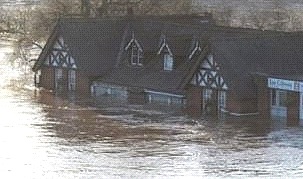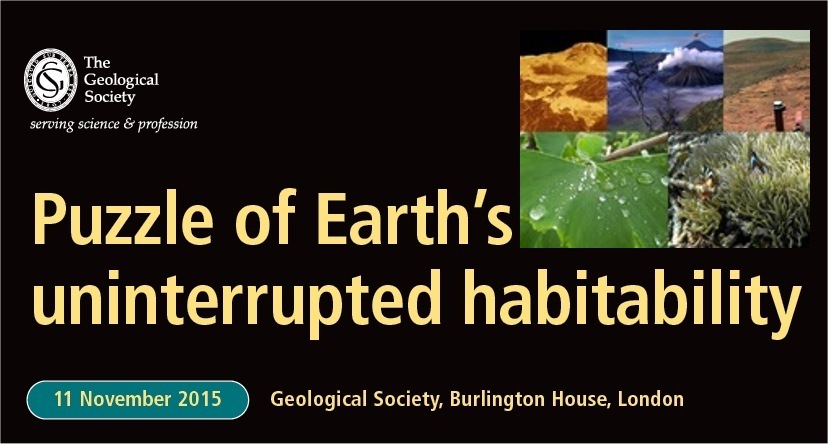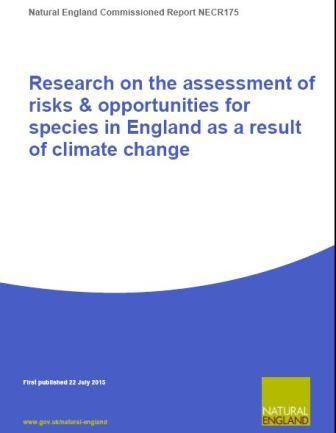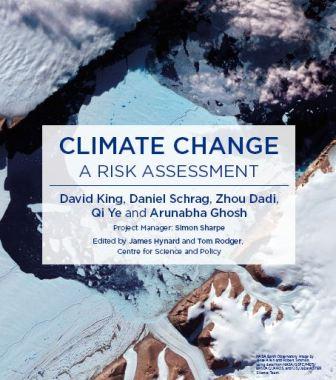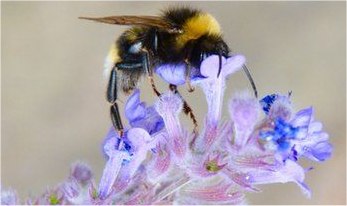|
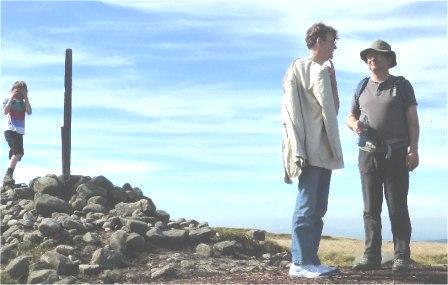 Simon (former Peak District Climate Change & Transport officer) showing Jonathan upland peat loss back in 2012's late summer. A century ago the upland peat on which we were standing would have all but covered us as indicated by the pole marker in the background left by science son. You probably don't need reminding, peat is such a carbon rich soil that dry it out and it can be used as a fuel.
Simon (former Peak District Climate Change & Transport officer) showing Jonathan upland peat loss back in 2012's late summer. A century ago the upland peat on which we were standing would have all but covered us as indicated by the pole marker in the background left by science son. You probably don't need reminding, peat is such a carbon rich soil that dry it out and it can be used as a fuel.
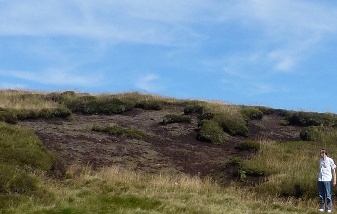 Britain's Peak District National Park recent upland peat erosion (the large dark area centre) with no vegetation cover.
Britain's Peak District National Park recent upland peat erosion (the large dark area centre) with no vegetation cover.
It should be noted that globally most soil carbon loss is from boreal soils and marginal permafrosts. This picture demonstrates that
some temperate high carbon soils are currently losing carbon. Soils in tropical areas remain a net sink. There primary production (effectively plant growth) is high and outstrips carbon loss. It is also thought that 1°C warming in boreal soils effects enzyme activity far more than
1°C warming in sub-tropical high-carbon soils. (Meanwhile the picture for some tropical high-carbon soils is currently unclear.)Climate Change: Biological and Human Aspects (2nd edition) has been used in devising
the Peak District's National Park's Climate ChangeAdaptation Report 2016. Their planning processes follows a simple approach - hope for the best and plan for the worst. It considers the consequences of a 2°C rise in global temperatures by 2040 and a 4°C rise by 2100. It also notes the difficulty in identifying thresholds. The problem is not that in its report the Peak District National Park does not accept that there will be critical transitions (it does recognise the issue),
but that funding the long-term monitoring (assuming it knew what to monitor) is difficult.
|
Concatenation Science Communication
Past news 2015/16
Autumn 2016 New research and we now have a handle on the soil carbon critical transition that will boost climate change and likely take us across a climate threshold. Those of you -- the dedicated few who have been following my climate science shenanigans closely -- will be aware that I am concerned that we are heading for a 'critical transition' in the Earth system that will take us across a climate threshold. I mentioned this in my 2013 Climate Change: Biological and Human Aspects (2nd edition), see: the introductory acknowledgements, p95, p103, p355-359 and p465, as well as with regards to soil carbon p433-438. Actually the Earth system is very complex and while it is (I and a few others contend) likely that the Earth system will jump to a new state (seeing a sudden -- albeit taking many years if not decades -- rise in temperature of a few degrees) as opposed to a more gradual rise, there are actually a few sub-systems that could go through a critical transition as part of our crossing an overall threshold. Anyway...
Now, Thomas Crowther and colleagues have given us an idea when soils globally will cease becoming a carbon sink (with plants growing roots whose carbon then largely remains in the soil after the plants die) to becoming a carbon source: soils were thought likely to be a net carbon sink in the IPCC 2007 report (WGI section 7.3.3.1.6.) and soils are some of the sub-systems contributing to the Earth system.
The researchers looked at 49 field studies in which soil was warmed at different sites around the world. They then extrapolated their findings using a statistical model to reveal the probable upper limit of changes in soil carbon by 2050 assuming this time when the average global temperature will have increased by around 1°C. A reasonable business-as-usual
climate scenario would drive the loss of 55 ± 50 petagrams (or gigatonnes) of
carbon from the upper soil horizons by 2050. This value is around
12–17 % of the expected anthropogenic emissions over this time and would add an extra 25 parts per million (ppm) to the atmospheric carbon dioxide concentration (currently around 400ppm) between now and 2050. The authors note that current computer climate models do not properly take this into account. (The limitations of computer models is also something to which I refer (p36 and p102, p146 - which references soil carbon, p234, p236, p238-240 and p516.))
Of course, it has to be said that the Crowther paper only gives us a rough handle on the issue: only 49 sites were used and none were in the southern hemisphere. Nonetheless this is a work whose importance should not be underestimated.
The reference for the Crowther and colleagues' paper is Crowther, T. W. et al. (2016) Quantifying global soil carbon losses in response to warming, Nature vol. 540, pp104–108, and there is also an accompanying review by Eric Davidson, Nature, vol. 540, pp47-8.
|
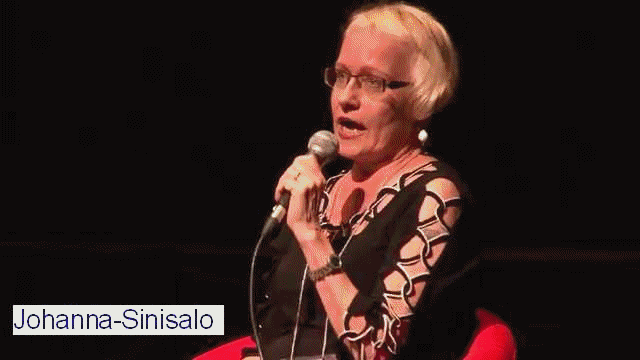 November 2016 saw many lights of western Europe's SF community gather in Barcelona for Spain's first Eurocon.
November 2016 saw many lights of western Europe's SF community gather in Barcelona for Spain's first Eurocon.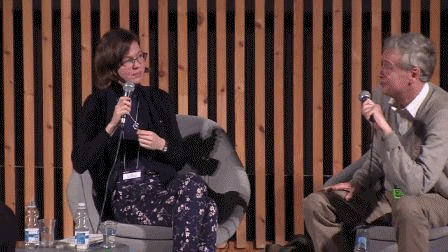 Biologist Julie Novakov with Jonathan on the 'Where are they?' Fermi Paradox panel.
Biologist Julie Novakov with Jonathan on the 'Where are they?' Fermi Paradox panel. |
Autumn 2016 Barcelona and the 2016 Eurocon. It has been a few years since I did the annual
science fiction four-day Eurocon but this one was rather special in that it was Spain's first Eurocon. A good Eurocon is a great place
to network and catch up with some of the key players in the European SF community, plus make new contacts and get a sense
of the current buzz: apparently there were over 800 attending.
It was also the first Eurocon since the UK referendum
to leave the European Union (so-called 'Brexit') which made the Barcelona, Catalan, venue all the
more interesting given the current and historic relationship between Catalan and the rest of Spain. This was particularly
highlighted in two ways. First, the convention goody bag contained a tri-lingual edition (including the first
ever English translation) of Catalonian, Manuel de Pedrolo's
Typescript
of the Second Origin:
a progressive (with a female and non-Caucasion protagonist), post-apocalyptic novel. de Pedrolo
fought against the communists in the Spainish Civil War only to be betrayed with Franco making
speaking Catalonian illegal etc: the tensions between integration and localisation were obvious.
The second thing was that there was much discussion among the few US Americans present
of the (then) imminent US Presidential election. Few had much positive to say about either
candidate though there seemed to be a very clear universal preference for one over the other.
(These US citizens were to be disappointed a few days later, but then these Americans, being in
Barcelona, represented the more travelled and privileged of their fellow country folk.)
|
|
The Eurocon programme saw a couple of streams largely in Spanish,
a stream with a fair bit in Catalonian, and about three streams with programme items in English. The
programme was diverse which meant that there was something for everyone, but the flip side was that there was
little (just half a dozen items or so) science. My own minor contribution was to a small panel
attended by a couple of hundred or so on the
Fermi Paradox. The conclusion of which was that
in terms of both science and SF there are plenty of explanations for our not seeing/detecting an
extraterrestrial technological civilisation even if there are a score or more such species currently in our
150,000 light-year diameter spiral galaxy. We therefore cannot use Fermi to deduce the presence or not
of other technological species.
Barcelona is an interesting city with much to see. Fortunately, despite
its reputation for being the pick-pocket capital of western Europe, none of us had any trouble, but then we were
on our guard and had numbers on our side.
This was an admirable Eurocon -- Eurocons can be somewhat
of a variable feast -- and many nations who have previously run a Eurocon would have been proud
to have run one that was largely as good as this, Spain's first.
Those going to the Eurocon next year have Dortmund ,Germany, to look forward to:
I went to the previous Dortmund Eurocon in the 1990s which itself was interesting as that was just a few
years after East and West Germany re-unified. The year after that (2018) will be Amiens in
France and a chance to see Jules Verne's house.
|
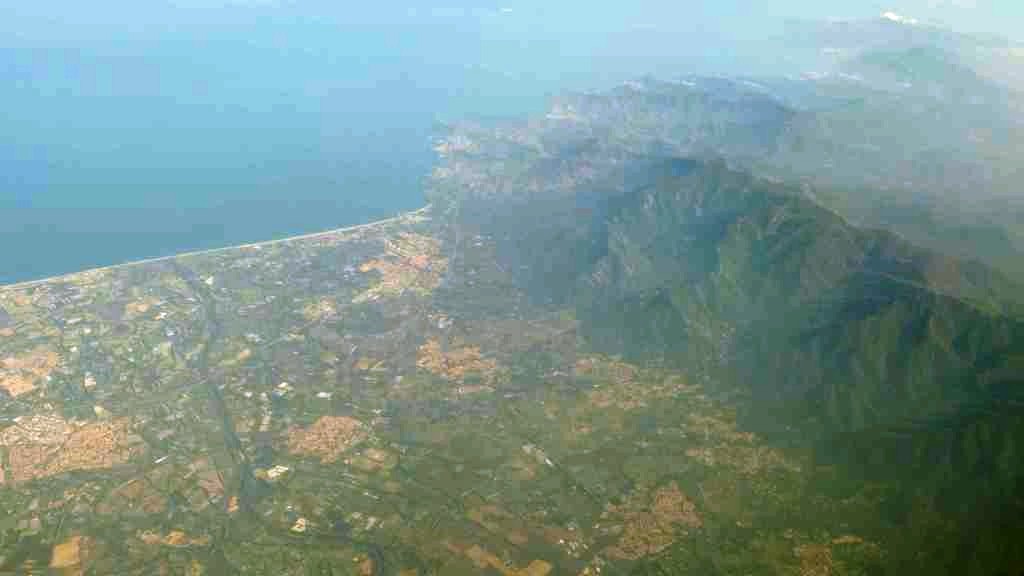 The French side of the Pyrenees western
The French side of the Pyrenees western
edge up against the Mediterranean by
Argeles-sur-Mere: a species block.Also note the dense patchwork of farm
fields. Nearly all of lowland western Europe
is covered by either largely monocultured
fields or towns and so is bio-diverse poor.
This too impedes species migration
through the landscape. But that is another
climate change story...
|
Autumn 2016 Mountain ranges as a block to climate change species shift. On the way to Barcelona (see above) I was struck by the aerial view of the Pyrenees mountain range between France and Spain. East-west mountain ranges impede the northern migration (in the northern hemisphere) of species in a warming climate: they reach the range and then start going up in altitude. Species already
in the mountains go further up in altitude, and not further north in latitude. During the Quaternary glacial-interglacial transitions east-west
orientated mountain ranges such as the Pyrenees and the Alps blocked the migration of plant species to the extent that this is reflected
in their genetic diversity. With specific regards to the Pyrenees, the genetic diversity of a number of trees and shrubs in Spain is lower than France and the rest of Europe to the north as species were trapped on the Iberian peninsula. The flip side to this problem (if a natural phenomenon is a 'problem') is that the genetic diversity
of plant species around such ranges is higher: strains migrate to and from such refugia with climate change. (See Pétit, J. R. et al (2003) Glacial refugia: hotspots but not melting pots of genetic diversity. Science, vol. 300, p1563-5.). And with that thought I had another Chateau neuf de British Airways...
|
|
|
Autumn 2016 The current Paris Climate Accord will not keep warming below 1·5°C above pre-industrial says the International Energy Agency (IEA). The IEA has used part of its World Energy Outlook 2016 to examine (i) whether we are on the 'policy' (as distinct from actual 'emissions') trajectory to meet the recent 2015 Paris Climate Accord, and (ii) whether we will achieve the Paris Accord goal of keeping warming below 2°C above pre-industrial and also its aspiration to keep warming below 1·5°C.
The answer to 'i', says the IEA, is that the policy track the Accord laid out is being followed. Good news. But the answer to 'ii' is that -- if we continue as we are -- the total fossil carbon emissions budget that will result in 1·5°C warming will be used up by the middle of this century (2050). Even to keep warming below 2°C (this century) we need atmospheric carbon dioxide concentrations to be below 450 parts per million (ppm) of which the IEA says 'the challenges to achieve the 450 Scenario are immense'. (Atmospheric concentrations have already passed 400ppm.) If this was bad enough, then consider the Paris Accord's more ambitious aspiration to keep warming below 1·5°C. Here the IEA say that 'the transformation required for a reasonable chance of remaining within the temperature goal of 1·5°C is stark. It would require net-zero emissions at some point between 2040 and 2060 (even if negative emissions technologies can be deployed at scale), thus requiring radical near-term reductions in energy sector CO2 emissions, employing every known technological, societal and regulatory decarbonisation option'.
So you can take your pick, according to the International Energy Agency, between an 'immense' or a 'stark' challenge. As for my personal view, well once more I remind you that back in 2009 I said that (scroll down a little here) 'it seems very likely (without a really major change in global human behaviour) that we will exceed our 'safe' 2°C above pre-industrial level (or 1·2°C above the Earth's 2006/7 temperature) warming'. Despite after over a quarter of a century of the UN's IPCC we have yet to get a firm grip on the problem of global climate change.
|
|
2016 sees the 70th anniversary of H. G. Wells' death and the 150th anniversary of his birth.
|
Autumn 2016 Time for a bit of whimsy to mark the 150th anniversary of H. G. Wells' birth and
70th of his demise. The leading, weekly multidisciplinary journal Nature marked this with an edition with a section
of articles looking at science fiction (SF) and its relationship with science. Now, you may recall that Wells' War of the Worlds
ends with the Martian invaders halted having succumbed to Earth microbes. All well and good, so back to the Nature SF edition.
Coincidentally, elsewhere in it there was a news item on NASA having to reconsider its Curiosity Mars rover's path which threatened to come close
to an area that may have water, hence potentially be a home to hypothetical Martian microbes. But there is an international convention not to contaminate Mars
and the Curiosity Mars rover may harbour Earth microbes that could contaminate potential refugia for Martian life; a concern that is a reverse of The
War of the Worlds scenario. Science fiction
sometimes predicts what will eventually become science fact, in this instance it has mirrored it. Being something of a wag, I pointed this out to Nature's editorial team. It was a bit of a pleasure that the folk
at Nature decided it was a wry observation they would share with its readers on its correspondence page (see bottom right). (Sole letter-only version archived here.) Reference: Cowie, J. (2016) Correspondence: Martian dance of fiction and fact. Nature, 358, 317.
|
|
|
Autumn 2016 SF Gateway celebrates one million e-book sales and its 5th anniversary. As a scientist into science fiction,
one of the joys of living The Big Bang Theory for real is getting invited to the occasional trade jolly. And so it was I found myself
at the SF Gateway e-book imprint's 5th anniversary that also marked their selling over a million books. The event was hosted by Gollancz
(from which Gateway spins out) and held in the London mega-bookshop Foyles. A score or more of Gollancz authors were present including
some of their online SF Encyclopaedia compilers, added to which there were a dozen or so of Gollancz staff, author agents and other luminaries of
the Brit SF community. The SF encyclopaedists also had something to celebrate: the on-line rolling edition began in 2011 with the 2nd print edition's 1.3 million words, but now (2016) the on-line rolling edition sports over 5.2 million words; as Gollancz publicist Stevie pointed out, if it existed in paper form and a copy fell on you it would kill you. The evening saw a great bash, well organised. Alas, over three hours I barely got around
a quarter of those present but I did get to float SF² Concatenation's (Concatenation's arts-science genre wing)
Graham's idea for a series of articles on scientist-turned-SF-writers' top
ten scientists of the 20th century, so hopefully a few Gollancz authors will be among the first of a possibly lengthy run
of such articles. The gathering was also a chance to catch up with past acquaintances, such as Rob Grant of the
Sci-Fi London film fest (see picture) and for my to have my occasional fan-boy moments including with Alastair Reynolds (also pictured). Thank you Gollancz for the evening. And the rest of you, do Google/Bing/Yahoo (whatever) 'Gollancz SF Masterworks' for a run of some of the world's classic SF book titles available in electronic form.
|
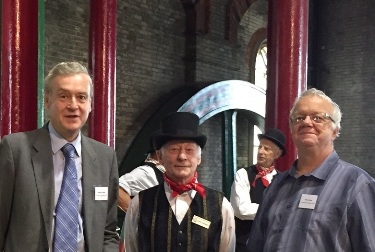 Jonathan and Alan (Concatenation webmaster) with Victorian Crossness mechanic.
Jonathan and Alan (Concatenation webmaster) with Victorian Crossness mechanic.
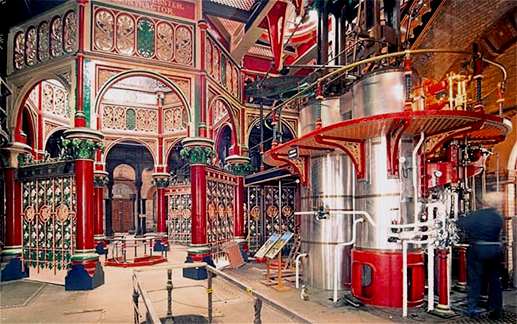 Excellently crafted iron work at Crossness that is positively cyberpunk.
Excellently crafted iron work at Crossness that is positively cyberpunk.
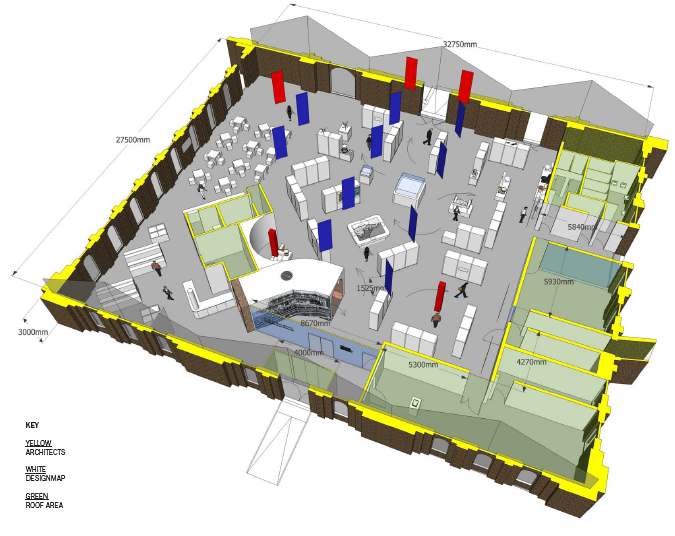 One of the preliminary sketches for the new Crossness exhibition hall part of the
One of the preliminary sketches for the new Crossness exhibition hall part of the
£3 million development.
|
Summer 2016 The Crossness Engines Trust opens its new exhibition hall. Last year saw
the 150th anniversary of the opening of the Crossness pumping station that helped end the Great Stink
by tackling South London's sewage. (There was a similar pump on the north side of the River Thames though it no longer exists.) The end
of the year long 150th celebrations culminated on the opening of Crossness' new exhibition which has been a long time coming. Crossness
is not just South London's second most important industrial heritage site (the most important being Tower Bridge) it is representative of
London's ground-breaking (in more ways than one) Victorian sewage system designed by Joseph W. Bazalgette. In total (north and south of the Thames) the
area serviced by Bazalgette's system was over 117 square miles. The length of the drainage sewers was 82 miles necessitating pumping engines at each of the two outfalls of some 2,380 horse power (1.775 megawatts in modern parlance). The opening of this system by Queen Victoria in 1865 not only ended the Great Stink that
affected Parliament let alone average Londoners, but ended the until then chronic public health problems from the previous ramshackle sewerage system such
as cholera outbreaks. But to my mind the technology of Crossness and the Bazalgette system was key to the start of global urbanization.
The industrial revolution saw the beginnings of agriculture's mechanisation that boosted output enabling a larger population. With treatment systems such as Bazalgette's it was possible to deal with the waste arising from all that food consumption. Consequently, both improved agriculture and large-scale
sewage treatment were fundamental to enabling large cities to exist. And so the balance of the world's population began to shift from being largely
rural to being largely urban. Globally, the proportion of people in urban areas rose from 29% in 1950 to 49% in 2005 and is expected to reach 69% by 2050
(People and Planet, 2012, Royal Society, London). This was paralleled by a growth in the global population, that was very roughly
a billion when Crossness opened in 1865, passed two billion around WWII, three billion in 1960, four billion in 1974, five billion in 1987, six billion in 1999 and seven billion in 2012: a population whose size is not possible unless it can be both fed and kept clean.
My own presence at the exhibition's opening was due to having provided Crossness with a press liaison service for nine years up to 2014. I attended the new exhibition hall opening with Concatenation's webmaster Alan who several years ago had for over a decade worked for Crossness ending up on its board. Among those also attending was Bazelgette's great, great grandson, Sir Peter Bazelgette.
|
 The Bramble Cay (Melomys rubicola), the first mammal to become extinct due to climate change.
The Bramble Cay (Melomys rubicola), the first mammal to become extinct due to climate change.
|
Summer 2016 It's official! The Bramble Cay is the first mammal to become extinct due to climate change. The Bramble Cay species name is Melomys rubicola (Melo = Melanesian, mys = mouse; rubicola = Bramble (Cay). It is a mosaic-tailed rat, distinguished by the mosaic pattern of scales on its tail rather than the concentric rows of scales running along the length of the tail found in most other types of rats and mice.
It was only found on Bramble Cay, a small, low-lying vegetated coral cay (a reef island composed of coral rubble and sand) roughly 340 m long by 150 m wide, but subject to seasonal changes in both shape and size, located at the northern tip of the Great Barrier Reef. This made it Australia's most isolated species of mammal. The island being small and low-lying has meant that it has shrunk over the past century as sea level has risen and extreme weather events taken their toll. It was not known whether or not it had gone extinct but now survey work in August–September 2014 has been completed and written up. This in turn has led to the announcement in June that the Bramble Cay has officially become extinct and the first mammal to do so directly attributable to climate change. (See: Gynther, I., Waller, N. & Leung, L.K.-P. (2016) Confirmation of the extinction of the Bramble Cay melomys Melomys rubicola on Bramble Cay, Torres Strait: results and conclusions from a comprehensive survey in August–September 2014, and also Watson, J. (2016) Bring climate change back from the future. Nature, vol. 534, p437.)
|
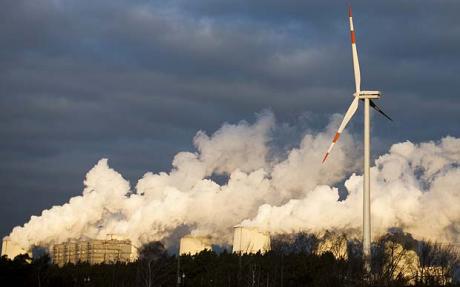
What warming would result if we burnt all the economically recoverable fossil fuel?
|
Summer 2016 How much warming would there be if all the world's economically recoverable
fossil fuel were burned? A pre-print of a paper in Nature Climate Change, by
Katarzyna Tokarska and colleagues from Canada, has just been posted. Entitled 'The climate response to five trillion tonnes of carbon',
it concludes that there would be a global mean warming of 6.4–9.5°C, but the temperature rise at high latitudes (Arctic)
would be greater at 14.7–19.5°C. (To put this into some context, the average global temperature difference
between a glacial ['ice age'] and now is between 4° and 5°C and possibly as much as 7° or 8°C in the Arctic.)
These results indicate that the unregulated exploitation of the fossil fuel resource
could ultimately result in considerably more profound climate changes than previously suggested. Of course,
the Earth has been this warm in the past (and so life will survive) but has not been as warm as this for millions of years and so
will be critical for non-tropical biomes (temperate, boreal etc).
Now, I have not yet read the full paper (I do not subscribe to Nature Climate Change) and so can
only see the abstract and the first page. Nonetheless, I wonder whether the CMIP5 models they use fully
capture long-term feedbacks (such as carbon release from soils)? If the models don't, then the warming could well be
even greater still! This would mean that their results are a good indication of the lower limit to possible warming.
However I will get around to reading the whole paper when it goes open access, especially as
the paper has cited Climate Change: Biological & Human Aspects (2nd ed.)
as one of its 30 references.
|
Personally, I prefer Rollerball: the 1970s version not the newfangled 21st century game.
|
Spring 2016 It has been party time in Leics with Leicester City winning the Premier League! Against much odds, the Foxes have won the Premier League. Who would have thought it? The betting shop odds at the beginning of the season were over 5,000 to 1. That means – as some did – placing a bet of just £10 netted a win of £50,000 (US$70,000)! The real party took place some miles away in Leicester itself. But scientifically I could not help but think of the way that in life small leptokurtic distributions within larger, distributions with long tails crop up time and time again. In this instance the factors those in the betting industry use to calculate odds were blind-sided by failing to properly take into account the mix of team-member ability, team training and the happenstance of the premiere draw of who played whom.
In real life we use a range of climate models but some that take into account, or weight more, some factors that other models do not, and these few models may come up with radically different results to the majority of other models.
Another example might be the risk of a crop being contaminated by pollen from its GM (genetically modified) counterpart. Commonly – and this is the main probability – the risk of such pollen contamination gets less with distance and so those producing the seed for crops themselves have to ensure that their crops are sited more than a certain minimum distance from crops of the same species to avoid contamination: these are official agricultural regulations.
|
|
|
All well and good, but suppose one year GM farmers decide to go to a conference in another country around the world. In this instance a second, lesser GM transference probability comes in to play due to the farmers' movements. For example, GM pollen might get caught in a farmer's turn-up or other clothing and is then carried around the world to contaminate a very distant crop.
Small, but sharp (slender) peaks within the tail of an otherwise bigger and broader probability distribution are 'leptokurtic' (leptos comes from the Greek meaning slender). They occur more often than you may think as sometimes in addition to a principal probability peak there may be a smaller but sharper, and certainly significant, peak tucked away at the far end of one of the main probability curve's tail. Keep an eye out for these as, against the odds, you may get a surprise result. The Foxes did in Leicester.
Notwithstanding the above, I cannot claim to be a football fan: rollerball is more my scene….
|
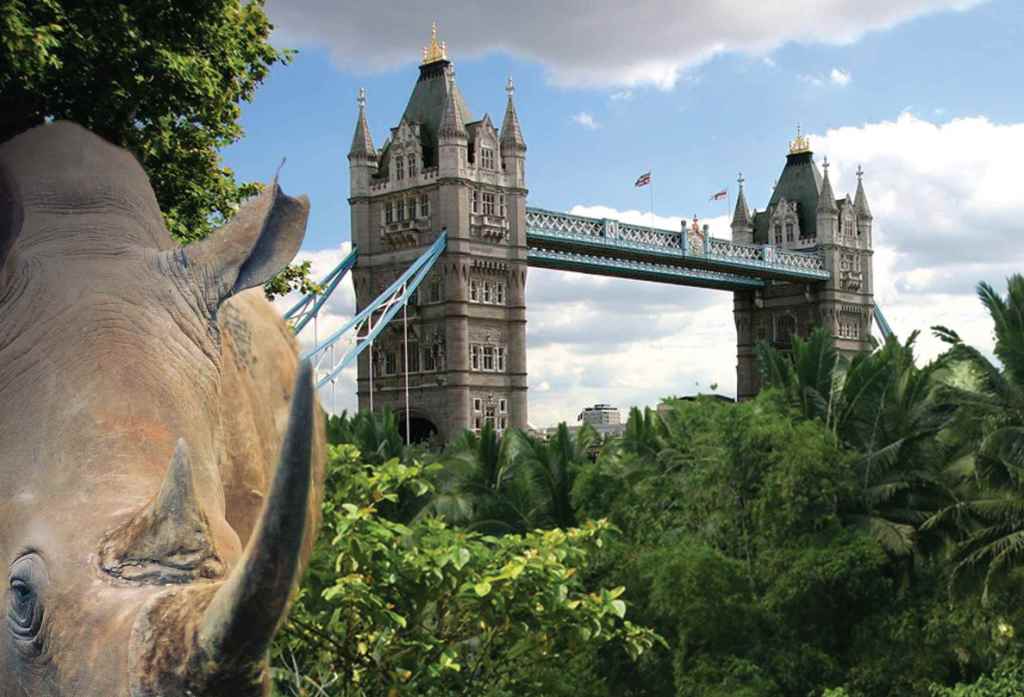 Possible climate change future for London under an analogue IETM/PETM carbon isotope excursion (CIE)
Possible climate change future for London under an analogue IETM/PETM carbon isotope excursion (CIE)
|
Spring 2016 Prof. Sir David Mackay F.Inst.P. has sadly left us aged only 48. David Mackay was the Chief Scientific Advisor (CSA) of Britain's governmental Department of Energy and Climate Change (2009-'14) and if you reside in Britain you will undoubtedly have occasionally seen him on the news or in television documentaries. Over the years, I have worked with a number of CSAs, though mainly with those more concerned with biology. However my interest in climate change meant that I encountered David a number of times and I invariably enjoyed his presentations. In 2009 he kindly took part in the end-of-symposium outreach panel on: 'Past rapid changes in CO2 levels and the climate system: lessons for the future' for the carbon isotope excursion (CIE) event that Anthony Cohen and I convened. His parting this April was when he was way too young. Fortunately, his contribution to climate science and energy use was recognised just a few months ago when he was made a Knight of the Realm for services to 'Scientific Advice in Government and Science Outreach': an honour well deserved.
|
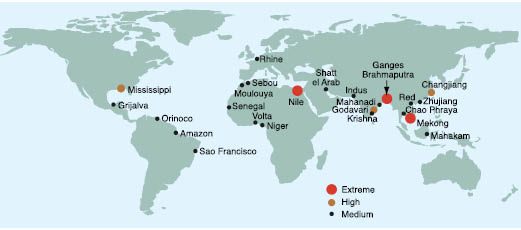 © IPCC 2007. Figure C3.1. from IPCC WG1 AR5 2013. Relative vulnerability of coastal deltas as shown by the population potentially displaced by current sea-level trends to 2050 (Extreme = >1 million; High = 1 million to 50,000; Medium = 50,000 to 5,000; following Ericson et al., 2006).
© IPCC 2007. Figure C3.1. from IPCC WG1 AR5 2013. Relative vulnerability of coastal deltas as shown by the population potentially displaced by current sea-level trends to 2050 (Extreme = >1 million; High = 1 million to 50,000; Medium = 50,000 to 5,000; following Ericson et al., 2006).
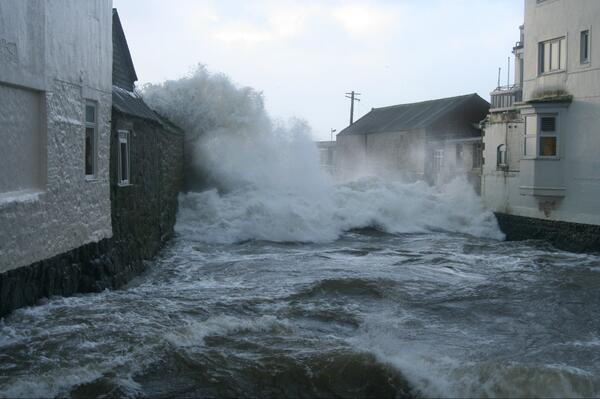 Sea storm surge Newlyn, Cornwall Sea storm surge Newlyn, Cornwall Thames Barrier: venue for a 1998 Environment Agency workshop on sea-level rise and London. (Despite this picture – it was coming up to dusk – it was a pleasant summer's evening.) Thames Barrier: venue for a 1998 Environment Agency workshop on sea-level rise and London. (Despite this picture – it was coming up to dusk – it was a pleasant summer's evening.) |
Spring 2016 A study in Nature reveals that sea-level rise are likely to increase in the further future faster than the IPCC predict they do today. Polar temperatures over the last several million years have, at times, been slightly warmer than today, yet global mean sea level has been 6–9 metres higher as recently as the Last Interglacial (130,000 to 115,000 years ago) and possibly higher during the Pliocene epoch (about three million years ago). In both cases the Antarctic ice sheet has been implicated as the primary contributor, hinting at its future vulnerability. The Nature paper by Robert M. DeConto & David Pollard. Their work suggests that Antarctica has the potential to contribute more than a metre of sea-level rise by 2100AD and more than 15 metres by the year 2500. The IPCC's 2007 AR3 1990-2100 'best estimate' for sea-level rise from all causes (thermal expansion and northern and southern hemisphere ice melt) is roughly a third of that now estimated by DeConto & Pollard for Antarctic melt alone and roughly half the IPCC 2007 high-level estimate. True, the IPCC upped its sea level rise scenario forecasts in its 2013/4 fifth Assessment Report (AR5) but the new DeConto & Pollard (2016) forecast for Antarctica melt alone is still a third again higher than the IPCC's AR5 best estimate for rise due to all causes (not just Antarctic melt) under its RCP 8.5 (business-as-usual) scenario and just a little over its high estimate!
Why do I draw your attention to DeConto & Pollard work? Well, estimating future sea-level rise from global warming is difficult. In Climate Change: Biological & Human Aspects I spent six pages on the possible surprises of sea-level rise estimates (Section 6.6.3 in the second 2013 edition). On p335 I noted that the sea-level during the last interglacial was 6m higher than today and that there were rapid jumps of 2-3m during which rise more than 36mm a year.
|
|
|
Yet in my last book I was being rather coy and conservative, just reporting the current reasonably established and accepted view from the science literature. (The job of that book was to report the science and not confuse students with my own wild musings.) You see for many years I have harboured the suspicion that we need to prepare for up to 2 metres of sea-level rise between 1990 and 2100AD. Indeed, back in July 1998 I was invited to take part in a climate change sea-level rise workshop by the Environment Agency at the Thames Barrier and opined, citing references from the peer-reviewed research literature, the need to worst-case plan for flooding up to 2 metres. Truth be told, many of the civil servants there were disbelieving, some (tut-tuttingly) vocally so. However I did receive support from one leading scientist present Hermann Bondi (former Chair of NERC and Chief Scientific Advisor to the Department of Energy). He noted my basing my concerns on bona fide research saying 'how nice it was to have a presentation based on actual data'.
So why was my 2 metre estimate for worst-case sea-level rise over the coming one hundred years far higher than the IPCC's? And why was Hermann Bondi interested in this wild concern from a then young scientist?
The IPCC – be it for better or worse – lays great store by computer modelling, and indeed many millions of pounds have been spent worldwide on such modelling since the IPCC's first Assessment (1990). Conversely, I only use models as in indication of possible likely change: instead, I lay greater store by what the Earth system has actually done in the past. Now, there are reasons why the IPCC does what it does: current change has no direct analogue in the past. Yet studies of past sea-level rise have shown rises of the order of a couple of metres a century both at the end of the last glacial and at times during the previous interglacial when global temperatures were comparable to today if not for a time a little warmer. Given this, and that current warming is faster, it seems to me that a reasonable conclusion could be that sea-level rise might, in the worst case, at the least be of the order of 2m per 100 years. Furthermore, the IPCC explicitly says in the main body of its scientific assessments that with regards to warming it is ignoring the difficult-to-quantify long-term feedbacks and also, with specific regards to climate change, in its AR5 (2013) noted that ice sheet instability had not been critically assessed. It is this last -- ice sheet instability -- with regards to Antarctica that the DeConto & Pollard take into account.
Since the 1998 workshop, some research suggests that sea level rise may be higher than the IPCC forecast. Previously unforeseen melt has been detected in the northern hemisphere (for example Gardner et al, 2011, Nature vol. 437, pp357-360), some new models also point to possible higher sea-level rise over the 21st century (for example Rahmstorf, 2007, Science vol. 315, pp368-370) and there have been other Antarctica melt estimates such as the West Antarctic Ice Sheet alone could contribute some tens of centimetres by 2100AD (SCAR, 2009, Antarctic Climate Change
and the Environment, Scott Polar Research Institute: Cambridge, Great Britain).
The official science view has over the years moved closer to my own. And so I ponder if, and possibly when, the accepted science view will one day affirm my concern that at a worse case we could possibly be looking at up to 2 metres of sea level rise over a century?
|
|
|
Winter 2015/6 The 2015 Conference of the Parties (COP) to the UN Framework Convention on Climate Change (FCCC), or the World's Climate Summit, as most in the media have it, was held in Paris. The resulting Paris Accord is the successor to the 1997 Kyoto Protocol. So, will it be successful? Well, if you have read the 2013 edition of my climate change biology and human ecology text, you'll probably have an idea of what I'm about to say. (The energy graphs are all there; the data is clear.)
The Accord laudably seeks to hold warming “well below” 2°C above pre-industrial temperatures and urges nations, if possible, to pursue an even stricter target of 1·5°C. How likely is it to succeed? Well, consider the success (or not) of the 1997 Kyoto Protocol. Kyoto aimed to reduce emissions by 5% of what they were in 1990 (though some nations were allowed a 1995 base year) by 2012. Did that happen? Errr..., looking back emissions rose every year since 1997 apart from a couple following the 2007 financial crisis. So going by past Kyoto performance, the Paris Accord does not seem promising.
|
|
|
But being realistic, are the Paris Accord's targets practically feasible? In theory 'yes', but it does mean some dramatic cuts. The Intergovernmental Panel on Climate
Change (IPCC) previously concluded that holding warming to 2°C will probably require emissions to be reduced from their 2010 levels by 40–70% by 2050. Achieving the 1·5°C target would require substantially larger emissions cuts of around 70–95% by 2050. So, with this in mind you can guess what I think.
And then a couple of weeks later, just as we were tucking into our mince pies, Kevin Anderson (the Deputy Director of Britain's Tyndall Centre for Climate Change Research) gave us a behind-the-scenes look at the Paris COP in Nature's Christmas edition ('Talks in the city of light generate more heat.' vol. 528, p437). Apparently the supporting papers at the COP suggest that the strategy for achieving these goals relies on biomass energy carbon capture and storage (BECCS). This basically means harvesting biomass, burning it to get energy, and then pumping the carbon dioxide into geological strata trapping it (hopefully) for millions of years. Itsy-bitsy problem. According to this plan the area of crops harvested will be close to three times that of India! Can you honestly see that happening in the mid-21st century, population swollen, hence hungry, world? Worse, while there was unease by some scientists present, it was reported that 'senior figures' and 'handlers' briefed against those who dared question the political reading of the science. You could hardly make all this up, and it seems more than a little Orwellian.
Of course, there are other ways to achieve the Paris goal, but high carbon taxation so as to pump massive investment in renewables and nuclear does not seem to be happening at anywhere near the level required, and we'd still have to curb air travel (while Britain's politicians currently agonise over a third Heathrow runway). Some circles simply cannot be squared. And then we really have to do something about that taboo topic of reducing global population.
STOP PRESS 30th June 2016: Over six months later and the above concerns as to the Paris Accord's feasibility have been echoed by a paper in Nature. Joeri Rogelj et al have calculated that the Paris Accord nations' intended greenhouse emissions (INDCs in climate policy speak) imply a median warming of 2.6–3.1 °C by 2100AD. Substantial actions are required to maintain a reasonable chance of meeting the target of keeping warming well below 2 °C. Rogelj, J. et al. (2016) Paris Agreement climate proposals need a boost to keep warming well below 2 °C. Nature vol. 534, pp631-639. All this sadly echoes the appraisal made in my 2009 essay Can we beat the climate crunch whose sentiments in turn were subsequently reflected by several others.
|
|
|
|
Winter 2015/6 Media and politicians act surprised as Britain's floods surmount new defences, while the UN COP climate summit in Paris takes place. While the world's political leaders met in Paris for the 2015 climate summit to derive an international treaty to succeed the 1997 Kyoto Protocol, the northwest of Britain saw over 5,000 homes flooded and in Cumbria alone 2,500 homes without power. The area has suffered from extreme floods before in 2005 and 2009 and new flood defences were created. But the rainfall has been record-breaking.
|
|
The Met Office said Honister in Cumbria received 341·4mm (13.4in) of rain in the 24-hour period from 18:30 GMT on Friday 4th December to 18:30 GMT on Saturday 5th. This beats the previous UK record set at Seathwaite, also in Cumbria, of 316·4mm (12.4in) on 19th November 2009.
Now, while we cannot directly attribute this December 2015 flood event to climate change, we can very definitely say that such extreme events are exactly what we expect with warming. This may seem a somewhat nuanced distinction but it is important that climate scientists be as precise as they can in statements lest public and political trust is lost.
Alas, not covered by the media is the latest academic paper from Met Office scientists that detailed the link between the 2013/14 extreme rainfall events with climate change. The winter of 2013/14 was one of the most exceptional periods of rainfall in England and Wales in at least 248 years. It marked the wettest December and January in the UK as a whole since 1910. According to the analysis, the odds of those storms bringing such extreme wet weather were seven times higher than on a planet that was not warming. Part of the reason is down to a relationship known as the Clausius-Clapeyron equation: so for each degree of temperature rise, the atmosphere can hold an extra 7% of moisture. The other part is that our warmer world is seeing air circulation patterns change and Britain is seeing the jet stream more often drive air circulation carrying water vapour from the ocean.
At the time of posting, the academic paper is not freely available, but it will be. If you are interested the reference is Christidis, N. & Stott, P. (2015) Extreme Rainfall in the United Kingdom during winter 2013/2014: The role of atmospheric circulation and climate change. Bulletin of the American Meteorological Society. DOI: 10.1175/BAMS-D-15-00094.I
|
|
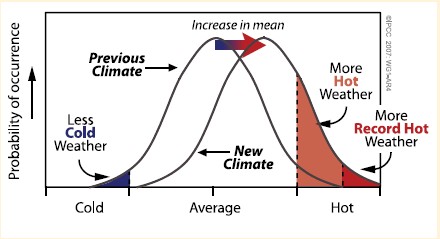 © IPCC 2007. The probability of extreme events increases disproportionally with warming.
This is from the IPCC AR4 Technical Summary for Working Group I.
© IPCC 2007. The probability of extreme events increases disproportionally with warming.
This is from the IPCC AR4 Technical Summary for Working Group I.
This graph relates to extreme hot weather events but it is equally applicable to extreme rainfall events in maritime climate zones and,
seemingly paradoxically, drought events in arid climate zones.
A small shift in the distribution (a small amount of overall warming) results in a large increase in extreme events at one end of the distribution.
This was made plain to governments by the UN's IPCC in 2007, so there
really is no excuse.
See also the sections beginning pages: 330, 355 and 358 in
Climate Change: Biological & Human Aspects, 2013. |
Personal thoughts:- The Clausius-Clapeyron relationship in this instance has to apply to 'extreme events'. While overall warming might seem small, such is the tail of the probability, Bell-like curve for the new warmer world curve superimposed on the past world curve, that the frequency of extreme events is greater! This means that it is not just prudent, but to be expected, that extreme events will increase in both frequency and intensity with time. Flood defences therefore need to be designed with an extra margin of error. As warming continues we must expect a continuation of record-breaking events. This means that we need to monitor the extent of each extreme event so as to maintain the margin of error enhancing defences with each record-breaking event. Failing to plan with this science in mind will see homes that might have been considered protected by new defences once more being flooded. Building flood defences on the cheap is a fool's economy; we need to plan and protect ahead of the curve, not on it, lest we end up behind it.
|
|
.
.
|
Autumn 2015 The Puzzle of Earth's Uninterrupted Habitability – More continuing professional development (CPD) with a symposium. Environmental conditions at the Earth's surface have been continuously suitable for life for more than three billion years. For example, temperatures have only varied by few tens of centigrade despite large changes in solar luminosity and atmospheric composition. Since the Archaean, the planet has not once been rendered sterile. However, the reasons for this long-term life-friendliness remain contentious. How has Earth’s climate avoided the runaway warming shown on Venus or the runaway cooling of Mars? Has Earth's relative stability resulted from geochemical feedback (e.g. through silicate weathering), the stabilizing influence of a complex biosphere (i.e. the Gaia hypothesis), good luck (e.g. purely fortuitous cancellation of solar warming by decreased greenhouse gas concentrations), or is long-term life-friendliness simply the consequence of life’s extraordinary adaptability (allowing it to survive even Snowball Earth events)?
This symposium brought together proponents of these various views in an attempt to forge a consensus on how to move the science debate forward.
|
|
The News Quiz
BBC Radio 4, 30th & 31st October
Autumnal series, episode 7.
|
Autumn 2015 30 seconds of fame. Just to field further questions
coming my way, yes, 'twas I being cited at the very end of Radio 4's News Quiz with some whimsy.
A deputy leader of a council led with his chin when commenting on an austerity decision to switch off street lights after midnight.
Apparently it was a decision 'not taken lightly'.
So that's 30 seconds gone of my Wharhol 15 minutes of fame. Looking forward to what the
fourteen-and-a-half minutes to come will bring.
|
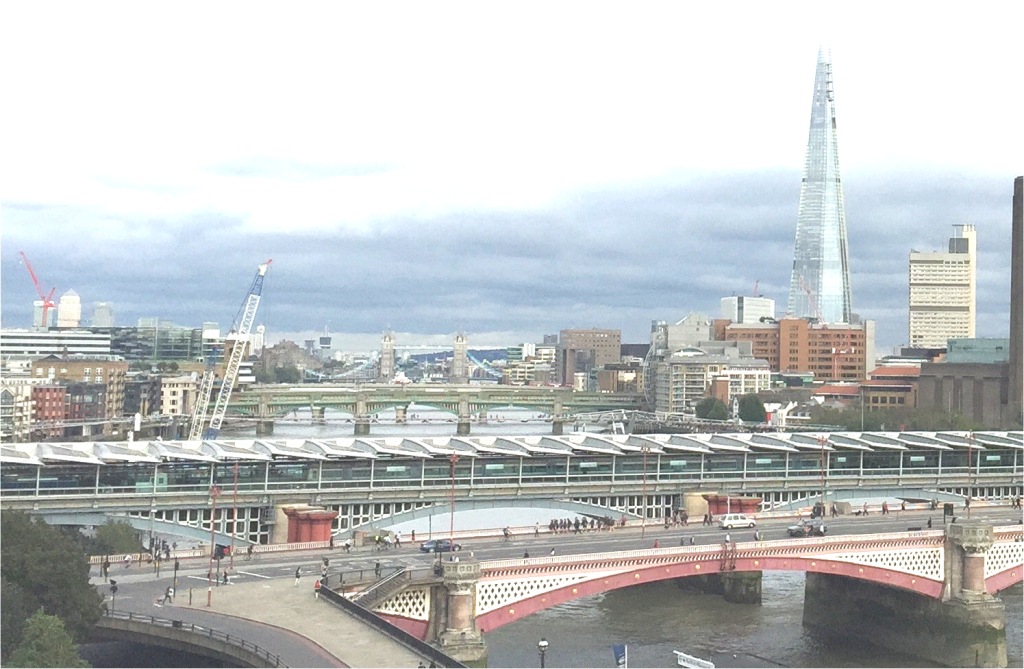 Looking east from Carmelite Ho towards Tower Bridge and the Shard.
Looking east from Carmelite Ho towards Tower Bridge and the Shard.
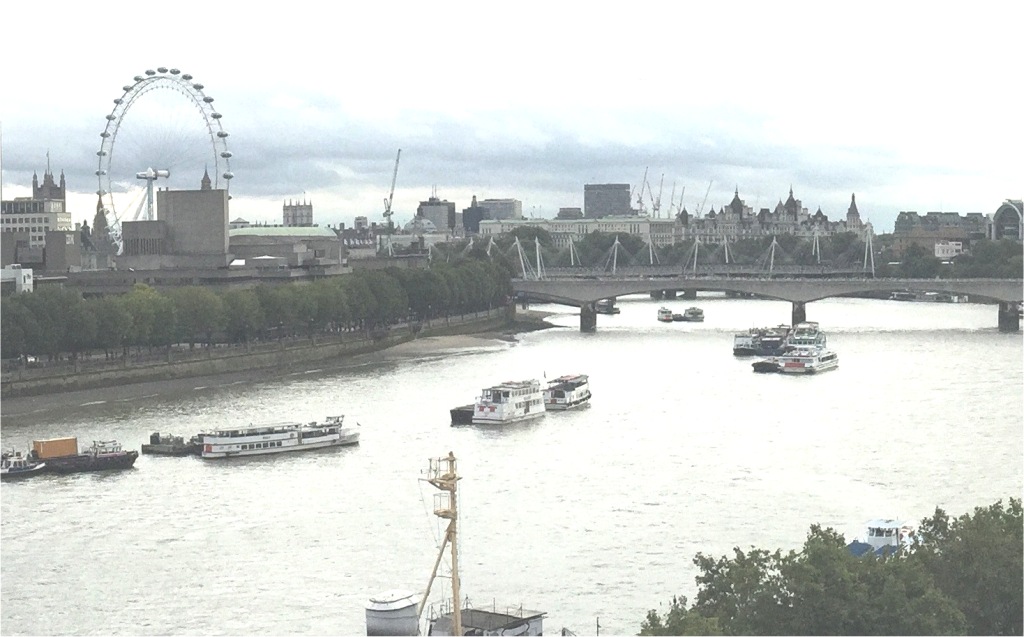 Looking west towards the London Eye and Palace of Westminster.
Looking west towards the London Eye and Palace of Westminster. |
Summer 2015 First sight of new Hachette UK HQ. Now, though I try to avoid them (time constraints) Concatenation regularly gets invited (which is nice), sometimes insistently (which is not), to book and film launches and other trade junkets (I coordinate our genre wing's news and reviews). However Hodder's promotional gathering this summer was of interest not just because it was a genre, multi-author affair, but it was the first time I had a chance to check out the new, ultra modern Hachette UK HQ sited in the heart of London right by the Thames. You may not know it, but Hachette owns a number of publishing houses some of whose names you may well be aware. The summer saw Hachette bring them all together for the first time under one roof in the newly furbished and internally revamped Carmelite House. Inside there is:-
5th Floor and Hodder (which also has specialist SF/F/H imprints of Sceptre and Coronet)
4th Floor contains Little Brown (which include imprints Orbit, Robinson and Corsair), Headline, and Quercus (which also includes the specialist SF/F imprint Jo Fletcher's Books)
3rd Floor is the home of Orion (with its SF/F imprints Gollancz and the e-book SF Gateway).
|
|
The Hodder gathering took place on the roof top which has a spacious bar overlooking an equally spacious roof-top garden that gave excellent views of the Thames. Sadly the sun was just setting and so the picture below does not do the panorama justice. Nonetheless, viewers can see the Houses of Parliament and London Eye to the west. The panorama below is a low resolution version of an original picture from which I have extracted blow-ups (see pictures to the above left) looking to the east and west. Thank you Hodder for the evening and bringing excellent company together.
|
|
|
Summer 2015 Natural England produces a climate change risk assessment for species. The independent government departmental agency responsible for promulgating England's biological conservation, and conservation policy, has produced a useful assessment. This worthy project deals largely with the potential for species' ranges to change under climate change. It also recognises that much can be done to increase resilience to change within existing distributions and this report may help to focus efforts to do this, as well as identify opportunities to facilitate range expansion. With regard to this last, they do leave out 'for how long' given how warming is beginning to progress (as exemplified by another report -- departmentally commissioned -- discussed in the next item below). Of personal interest (and further to my on-going behind-the-scenes chivvying -- see also below) the Natural England report does refer to species translocation. This is to be welcomed, but its coverage of this issue is very limited: the report looks at species translocation purely in the context of biological conservation albeit due to a conservation need arising from climate change. What it does not do is address the need for species translocation due to climate-induced biome shift, even if it does mention (not very clearly) new 'climate space' issues.
|
|
|
This may seem a subtle difference, more of nuanced, rather than fundamental, climate change ecology. But nonetheless it is a very important one! Some individual species will certainly need a helping hand as warming progresses; such as those at the top of uplands that become too warm and so need to be moved to a cooler environment further north (poleward). But single species' emergency helping hands fail to address the fact that key species (some even key to ecosystem function), and especially long-lived, fairly static species (such as trees) who may not be at threat now, will be within these species' generation or two's time. Climate-change-induced biome shift (and not just the failure of some individual species to track climate change) is still being ignored. Here, also overlooked are the lessons from palaeo-ecology as to how species responded to past climate change (such as between 20,000 and 10,000 years ago which saw climate change of a comparable temperature magnitude to that of today but a hundred times [two orders of magnitude] slower). This raises a raft of issues, such as: novel ecosystem creation and management; species' genetics (should genetic diversity be maximised, or just leading-edge genetic diversity preserved [that can be more easily done when things happen slowly], or main transient-body genetics and even the refugia population); let alone a raft of other issues (such as the aforementioned ecosystem function). We simply do not have the guidelines and protocols in place (as we do for single species translocation purely for conservation purposes).
OK, that's my comment over. Nonetheless, this really is a useful report with much in it to commend it. Even so, with regard to translocation in the face of climate-induced biome shift, a careful read with climate change biology in mind does exemplify that ecologists are beginning to become boxed in by the mounting evidence: it is now not a matter of if ecologists need to clearly address these issues, but when? (Reference: Pearce-Higgins, J.W., Ausden, M.A., Beale, C.M., Oliver, T.H. & Crick, H.Q.P. (2015) Research on the assessment of risks & opportunities for species in England as a result of climate change. Natural England Commissioned Reports no.175. Natural England: Cambridge.)
|
|
|
Summer 2015 A (UK) Foreign and Commonwealth Office commissioned report has been published by Centre for Science and Policy at Cambridge University: Climate Change: A Risk Assessment. With its lead author a former Government Chief Scientific Advisor and current UK Foreign Secretary’s Special Representative for Climate Change, David King, and sporting a politically endorsing Ministerial foreword by the Rt. Hon. Baroness Anelay, it has both political and science credibility. And it is also a very sensible assessment. Its principal conclusions are that we need to prepare for a warming of greater than 2°C.
On all but the lowest emissions pathways, a rise of more than 2°C is likely in the latter half of this century. On a medium-high emissions pathway (RCP6), a rise of more than 4°C appears to be as likely as not by 2150.
|
|
On the highest emissions pathway (RCP8.5), a rise of 7°C is a very low probability at the end of this century, but appears to become more likely than not during the course of the 22nd century. A rise of more than 10°C over the next few centuries cannot be ruled out.
It seems like just the other day – but it was over half a decade ago – that I warned that we would be very unlikely to keep warming to within the 'so-called' 2°C safe limit. At that time politicians, and a number of scientists associated with climate policy advice, considered it as almost heresy to say that we could not keep warming within safe limits (Nature (2014) 'Brace for impacts', vol. 508, p7). So it is personally refreshing to see senior scientists advising policy-makers, and politicians themselves, present a more impartial view as opposed to one wedded to a politically-determined policy track. Since 2009 I have been charting this shift and elsewhere on this site I have listed a number of key references over time. It gives me no pleasure to note that it has taken over half a decade for my original observations to become generally accepted. (I am now facing a similar situation over the need for species translocation protocols to address climate change induced biome shift; an issue for which I am still banging the drum behind the scenes. See also the item immediately below.)
Meanwhile, this new report seems to have been produced as a contribution to the debate six months before the UN climate COP meeting in December. Reference: King, D., Schrag, D., Dadi, Z. & Gosh, A. (2015) Climate Change: A Risk Assessment. Centre for Science and Policy. University of Cambridge: Cambridge, Great Britain.
|
|
|
Summer 2015 Bumble bees are failing to track with climate change according to research in the journal Science (vol. 349, pp177-180). For many species, geographical ranges are expanding toward the poles in response to climate change. Using long-term observations across Europe and North America over 110 years, the researchers tested for climate change–related range shifts in bumblebee species, and they are not shifting polewards!
|
|
|
The researchers did find range losses from southern range limits, and also shifts to higher elevations among southern species. But no range gains at higher latitude: the northern range limits.
Now, biome shift is to be expected with global warming as temperatures in low latitudes get too warm as well as also formerly cool temperatures at higher altitudes that warm to become new acceptable limits for bees. What is disturbing is that the researchers found failures to track warming over recent decades at species’ northern range (high latitude) limits: these failures occur in both Europe and N. America. This means that the species' overall range is declining.
In this case the cause seems to be that the species does not like to move far. For what it is worth here are some personal thoughts… Could it be that bees have a predilection not to wander too far from their hive and maintain this trait when setting up new hives? If so it would explain: the southern (low latitude) retreat (when it gets too hot the bees die); the failure to track at high latitudes (bees don't like moving); and the bees able to track climate by extending their range up mountains with warming (altitudinal/vertical change in climate zones occurs over a very short distance compared to the distance for analogous horizontal/latitudinal climate zones).
The few of you who follow my news pages, and indeed the 2013, 2nd edition of my climate change textbook (its appendix 4), will be aware that for the past few years I have been arguing for the need to consider species translocation to address climate change induced biome-shift and to develop guideline protocols. Currently, species translocation protocols (such as from the IUCN) were derived to address individual species conservation and not climate-induced biome shift in which factors such as conservation of ecosystem function need to be included among others. Sadly, despite very encouraging noises I've received from various stakeholders, to date it has proven difficult to get the ecological community to formally engage in considering this issue (though I did predict this difficulty in my 2013 appendix). However, in this case the researchers themselves do pose the question as to whether bees might be a candidate species for translocation due to climate change induced reasons.
|
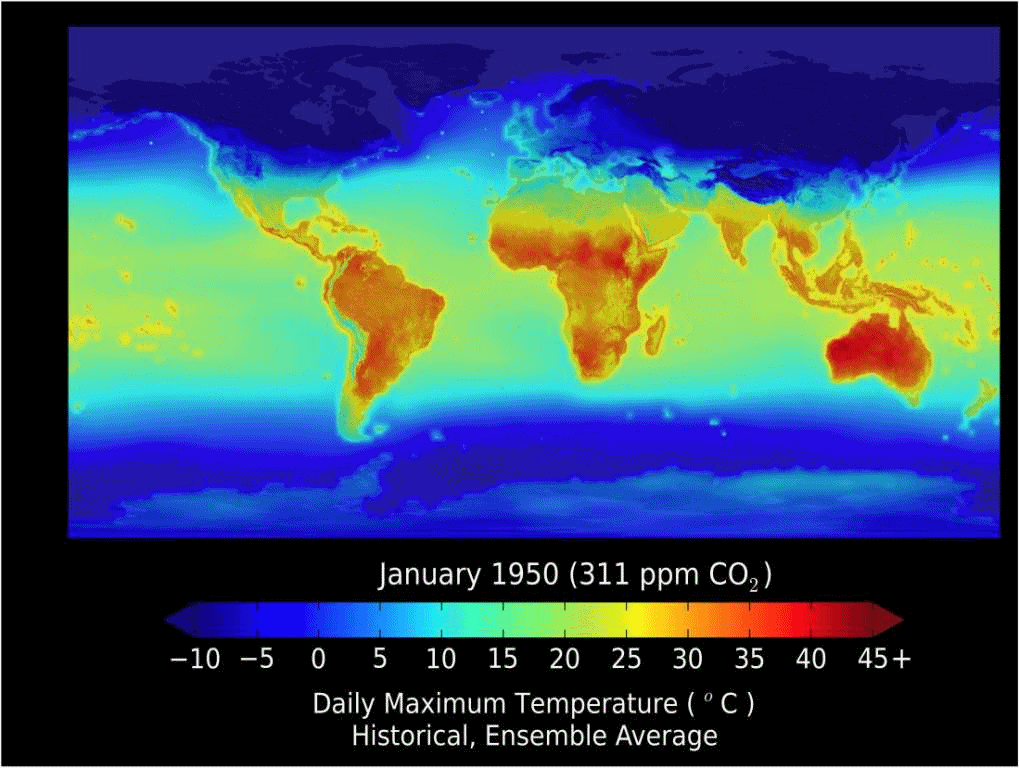 1950 actual and 2099 forecast January temperatures from the 2015 NASA data made publicly available. I could have presented June data but, with most of the Earth's land in the northern hemisphere (which has summer in June), that makes the warming seem more pronounced and I'd hate to scare the horses (but do note what happens in the southern hemisphere's January summer). Nonetheless, much of Britain will in 2099 likely experience frost free winters. In turn, one ecological impact of this will be increased surviving agricultural and garden pests.
1950 actual and 2099 forecast January temperatures from the 2015 NASA data made publicly available. I could have presented June data but, with most of the Earth's land in the northern hemisphere (which has summer in June), that makes the warming seem more pronounced and I'd hate to scare the horses (but do note what happens in the southern hemisphere's January summer). Nonetheless, much of Britain will in 2099 likely experience frost free winters. In turn, one ecological impact of this will be increased surviving agricultural and garden pests. |
Summer 2015 NASA has made its global climate change data set publicly available. It combines historical measurements with data from climate simulations to provide forecasts of how global temperature and precipitation might change up to 2100 under different greenhouse gas emissions scenarios. The picture on the left shows the difference in January temperature between 1950 and 2099 under business-as-usual (assuming we do not curb the current [early 21st century] trends in fossil carbon emissions).
For the technically minded, this is the IPCC's 2013 RCP 8.5 Ensemble Average scenario.
The new dataset is the latest product from the NASA Earth Exchange (NEX) based at NASA's Advanced Supercomputing Center at the agency's Ames Research Center in Moffett Field, California, USA. https://nex.nasa.gov.
NASA's move to make its data publicly available is one shared with academia as a whole on both sides of the Atlantic: it is increasingly common for science journals to make their data freely available. This 'open access' is ethically driven; after all the public have already paid for this research through their taxes funding universities and research institutes, so why should they pay for the research twice? There is also an argument that open access is good for science as researchers have the opportunity to be better informed.
|
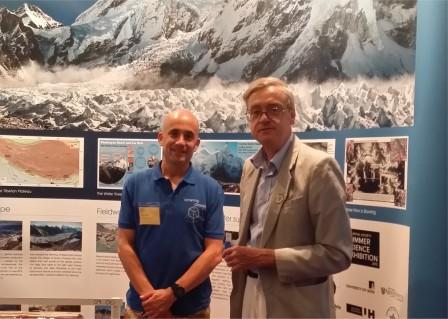 Climate change induced glacial melt exhibit
Climate change induced glacial melt exhibit
at the 2015 Royal Society Summer
Exhibition. .
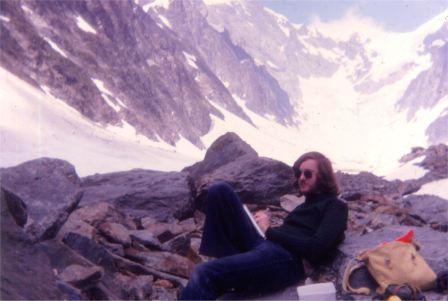 Late 1970s Jonathan making field notes
Late 1970s Jonathan making field notes
on a glacier's medial moraine. |
Summer 2015 This year's Royal Society Summer Fayre covered a number of areas of interest including: climate-change-induced glacier melt (yup, they're going…); the origins of life (it really looks like geothermal vents are key for energetic reasons, but please don't add the words 'deep sea'); and proving that the remains discovered in a Leicester car par were Richard III's (strange to come down to London to the fayre for something from not that far down the road). The annual Royal Society Summer Fayre is something I try to get to, and do quite a few years when I can contrive the diary for an in-town day engagement as there is always something of interest plus friends turn up for a social after. The surprising thing is that the fayre is not more popular: one of London's better kept secrets.
The glacier melt exhibit was of greatest personal interest, and doubly so when I found out that this display was put on by my old college, and that my old tutor is still working there being geological. It all took me back to one of my undergraduate fieldtrips and time on a glacier (at which point we'll skate over how I nearly fell down a herring-bone crevasse). The picture on the left sees a late 1970s yours truly taking field notes on the said glacier's medial moraine in northern Italy (Val d'Aosta). Mont Blanc is off picture to the right.
|
|
|
Spring 2015 Crossness celebrates its 150th anniversary. The Victorian sewage pumps ended London's Great Stink 150 years ago. Up to last year, for the best part of a decade, I had been providing the Crossness (restoration) Trust with its press liaison service. The 150th anniversary saw many who had been involved with the Trust over the years gather for a celebratory evening with heritage and local dignitaries.
|
|
|
Spring 2015 'Climate scientists eye alien worlds' proclaims a Nature journal news article. The article reports on how NASA is now using climate change Earth system scientists to model life-viable exoplanets. This is a welcome development, but one can't help but be mindful that over here in Britain, a number of us within the Geological Society's Earth System Science group have been using an Earth system science approach with climate change scientist to consider exoplanet biosphere viability for several years now. So this approach really is not that new but, hey, it makes for a good news story.
|
|
|
Spring 2015 How close does one have to be to a red sun for photosynthesis? Indeed, is photosynthesis possible under a red sun? These are just two questions I've been contemplating for future appraisal while penning my next opus.
If you are a biologist with a botanical bent and have any thoughts then do share.
(I'm thinking chlorophylls' absorption spectra on one hand and the lack of match between photosystems' wavelengths on the other: what's the blue absorption doing? Light harvesting mechanism is involved for sure, but why exactly reflect green?)
|
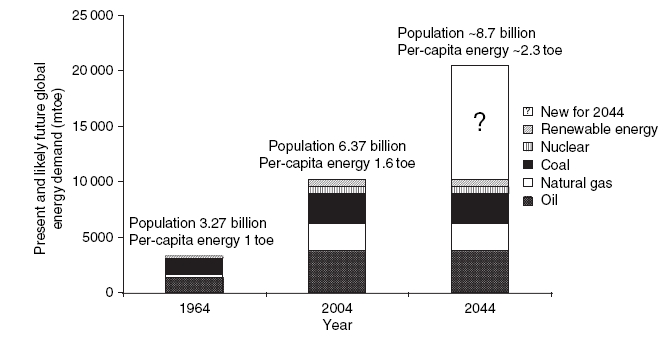 This graph I prepared in 2006 for my 2007 climate change book. There is well over the same amount of fossil fuel that we have burned to date still in the ground. Should recent trends 1964 – 2004 continue (as they have to 2015) by 2044 global energy demand will double (see above diagram from Climate Change: Biological and Human Aspects by Jonathan Cowie). And should we then double atmospheric carbon dioxide (which if we follow current trends we will do well before the end of the second half of the 21st century), then warming will exceed 2ºC above pre-industrial levels!
This graph I prepared in 2006 for my 2007 climate change book. There is well over the same amount of fossil fuel that we have burned to date still in the ground. Should recent trends 1964 – 2004 continue (as they have to 2015) by 2044 global energy demand will double (see above diagram from Climate Change: Biological and Human Aspects by Jonathan Cowie). And should we then double atmospheric carbon dioxide (which if we follow current trends we will do well before the end of the second half of the 21st century), then warming will exceed 2ºC above pre-industrial levels! |
Spring 2015 'A new key science paper constrains fossil fuel consumption to keep warming within the so-called 2ºC safe limit. This is an alert primarily for those who use my university climate change textbooks. Textbooks inevitably do eventually date but they still have several years life in them. Nonetheless a few key papers can come out quite soon after any textbook's publication. With regards to climate change, Christophe McGlade's and Paul Ekins', of University College London, paper is one such key paper. 'The geographical distribution of fossil fuels unused when limiting global warming to 2·0°C ' published in the science journal Nature notes that as of 2011 we need to keep two thirds of known reserves in the ground. Globally, a third of oil reserves, half of gas reserves and over 80 per cent of current coal reserves should remain unused from 2010 to 2050 in order to meet the target of 2·0°C. They show that development of resources in the Arctic as well as any increase in unconventional oil production are incommensurate with efforts to limit average global warming to 2·0°C. Furthermore, it is unnecessary for continued substantial expenditure on fossil fuel exploration, because any new discoveries, if used, will take us over the 2·0°C safe limit. See also a general review article on the paper, and if you or your institution does not have a subscription access to Nature online, then there is an open access BBC News page covering this story.
[Past news 2013/14]
[Current news ]
[Bioscience interactions | Climate change interactions | Science & Fiction interactions | What is Concatenation all about? | Home ]
|
|




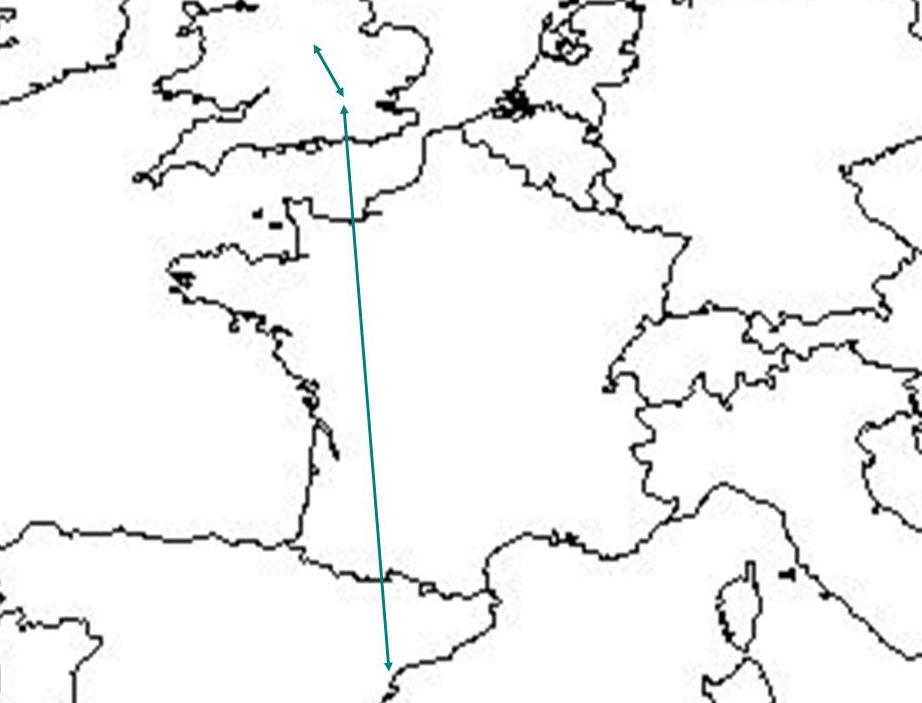


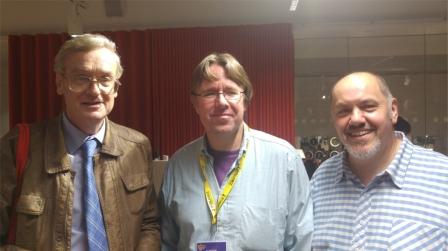








 Possible climate change future for London under an analogue IETM/PETM carbon isotope excursion (CIE)
Possible climate change future for London under an analogue IETM/PETM carbon isotope excursion (CIE)




